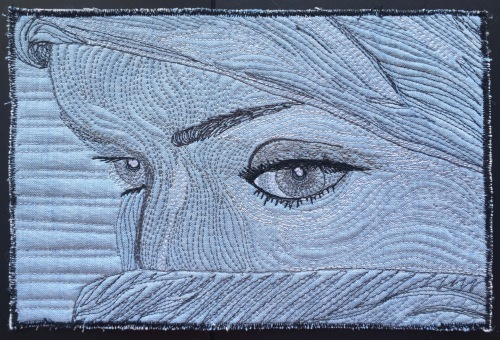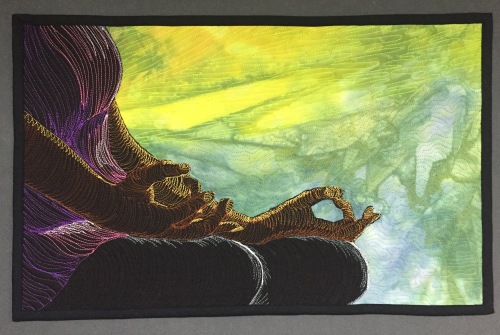A few weeks ago a new client of mine and fairly new to quilting herself, asked me….how do you square a quilt? She asked because I always measure a quilt I take in to make sure it’s “reasonably” square so I won’t run into major problems loading or quilting it.
A lot of new quilters believe it is the last step you do before you quilt it….or even the last step you do before you bind it. And then, there are those who don’t care…..
Taking a ruler and trimming off the edges sometimes works….but not often. If you have to trim off as much as a 1/4″ on a 4″ border, the eye is going to notice. So I don’t recommend you do that. If it’s not very far off, you can make the adjustment by cutting the batting/backing a bit bigger to make it square as long as you have enough of the top edge of the quilt to catch in the binding. On a very large quilt that is going on a bed, having it not square is not really going to matter. Only if you are hanging it on a wall, or putting it in a show, will it be noticed.
But if you do care about your quilt be square, then I suggest that it is the FIRST step you take when you start a quilt and it is the NEXT step you take after you’ve sewn a seam. In other words, to get a quilt to turn out square, you have to make everything square as you go. When you do that, in the end it will be “relatively” square.
Fabric is fluid, stretchy, and can be manipulated quite easily. So the first thing to know is how the straight of grain runs (along the length of the bolt, or the same direction the selvedges run). The selvedges are the finished edges that have a tighter weave and sometimes you can see the large holes left behind from the tacks used to hold the fabric in place as it’s dyed or printed. When fabric is woven, the “warp” is the lengthwise threads on the loom which has the most tension on it. The “weft” is the crosswise threads that are woven over and under the warp threads at a 90 degree angle. It has a bit more stretch when tugged that way. Any other angle of the weave is considered “bias”. At 45 degrees is the true bias and has the most stretch. But really any bias angle has stretch.
Now that we know something about the nature of fabric and it’s ability to stretch, we can minimize our quilt going “out of square” by first cutting accurately. Cutting long lengths of fabric with the grain can be costly and wasteful, so most quilters will cut across the grain and treat is like the grain. This is acceptable because there is only a slight difference in stretch. Another way to stabilize the bias of fabric is to use a paper or cloth foundation. That way you can cut any direction you want and keep the edges stable. The most common error is working with triangles. When working with triangles you always want to have the straight or cross grain on the outer edge. The bias should always be the edge that is sewn to the inside. There are many techniques written on how to achieve that. I have a video on how to make “Half-Square Triangles”.
Once you have cut properly, then sewing a straight seam is the next step. The best way to keep the seams straight is to pin. I have to admit that I “cheat” on small blocks and do not pin, but once they get bigger, I always pin. The other essential tool is to have an accurate 1/4″ foot on your machine. I always look to make sure I can see the edge of the bottom fabric as I’m sewing. If you can’t see it you run the risk of it going way off underneath and having a very narrow seam allowance or a non-sewn gap that can easily come apart and is no longer square.
Before continuing to sew blocks together I always press. You can easily chain sew before pressing, but if you are sewing a seamed piece to another, then pressing is an absolute must. The reason for this is, that the seam needs to be completely flat. You can press to one side, or open….whatever works best for your project. But you want to make sure you do not have a “lip” of fabric to one side of the seam. That will make a difference on the size of your block. In a pinch finger pressing works, but pressing with an iron is best.
As you are sewing patches, you want to take a moment to check to see if the resulting block is the size it’s suppose to be. Some techniques call for making them bigger and cutting them down to square. That is fine as long as your patches and blocks are the size they are suppose to be.
As you sew the blocks together either in rows or larger blocks, take the few minutes you need to check to see they are square. You’ll be glad you did. If the body of your quilt is square when you start to add borders, then they will go on easier. If it is not, then you will be compounding the degree it is off exponentially as the borders are added.
Am I saying that it has to be perfect???? NO! Fabric is fluid and can be manipulated, but only to a certain degree. On a queen or king sized quilt, I can ease is up to 2 inches difference on an edge without adding a pucker or pleat, but beyond that it’s really difficult. So when adding borders, you can manipulate the body of the quilt to be square. You can see how I do this in my video “How to add borders”.
When I find a quilt is way off and it has more than one border, the problem usually starts with the very first border or even the body of the quilt. That is why I’m an advocate of keeping things straight as you go. Because of this, some call me a perfectionist (see a previous blog post on perfection)….but I’d rather consider myself a detail person because getting the details to work make me happy…..very happy when I don’t have to rip and re-do things!!
So to summarize, follow these steps to make your quilt square:
- Cut accurately along the straight or cross grain of the fabric.
- Sew an accurate 1/4″ seam.
- Press your seams before sewing another piece on it.
- Check the size of the patches or blocks and correct if necessary before moving on.
- Continue checking the size of the blocks and rows as they are being assembled.
- Add borders on correctly, easing in any fullness as you go.
- Once the top is quilted, it should remain “relatively” square.
- The back and batting can be trimmed square and have the binding hide any small amount that may be showing.
Following these steps should make your quilt square and you very happy!!
Happy quilting!!
~Jo








































I have often in the past been accused of being a perfectionist. In the past I was proud to be one, until I noticed how my mother who was also a perfectionist, found extreme frustration and unhappiness when she could no longer be perfect once she started down the road of dementia.
I learned a lot from her regarding this subject. I realized that being a perfectionist left very little room for me to make a mistake and still feel good about myself. There was always that drive to do it over and over again until it was “perfect”, so I could feel good about myself and my work.
I have spent a fair amount of time contemplating this subject. My work is far from perfect. If you don’t believe me, then ask the quilt judges who have judged my work and found it FAR from perfect! I also have spent a lot of time looking closely at the quilts in a big quilt show that have won first place, or awards of excellence, or best of show, and have found that they are indeed nearly, if not perfect. I often wonder how these artists feel about themselves and their work.
So I have taken the heat off myself by not having everything I do needing to be perfect. Once I did that, I was much happier. The pressure was off. But what I did discover was that when I did something that was “not good enough”, I chose to rip and re-do. Or when I’m putting my work together, I find that if I pay attention to the details like cutting my fabric straight, or making my seams as near “perfect” by knowing my machines and tools really well, everything fits together better and find myself so much happier because I don’t have to rip and re-do.
To summarize, a perfectionist is one who views everything they do needs to be “perfect” at least in their eyes. When they do not perform up to that standard, they are not happy and do not feel good about themselves. I witnessed this in my mother.
But I label myself as one who pays attention to details which is much different than being a perfectionist. Details make me happy. Being perfect (nearly impossible to do) does not.
Sometimes when I teach a class, I am still accused of being a perfectionist. But my response is always the same: I am not perfect and I don’t require you to be perfect….you can ignore my techniques and do it your way, but paying attention to the details (so it turns out the way I want it to) makes me happy.
So I ask you again….do you want to be perfect or happy?
Happy Quilting!!
Jo
5 Comments
Posted in Uncategorized | Tags: details in quilting, perfectionism, quilting commentary